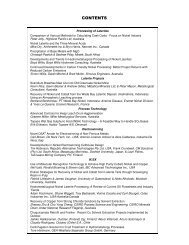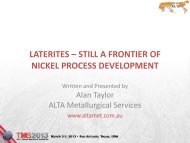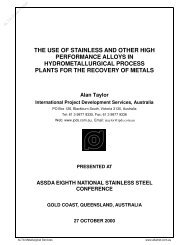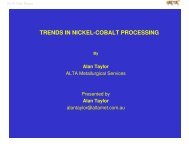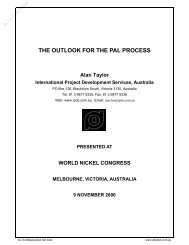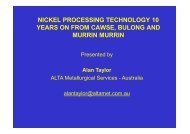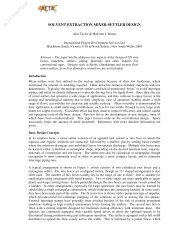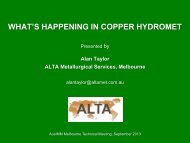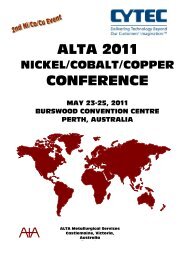review of mixer-settler types and other possible contactors for ...
review of mixer-settler types and other possible contactors for ...
review of mixer-settler types and other possible contactors for ...
You also want an ePaper? Increase the reach of your titles
YUMPU automatically turns print PDFs into web optimized ePapers that Google loves.
ALTA Free Paper<br />
4.2 ELECTROSTATIC MIXER-SETTLER<br />
Developed by CE Natco in the nineteen seventies <strong>for</strong> copper SX. In the mixing step, an emulsion is<br />
deliberately created which improves mass transfer. The <strong>settler</strong> involves the combination <strong>of</strong><br />
electrostatic <strong>and</strong> centrifugal <strong>for</strong>ces in an electrically charged hydrocyclone. The resulting cyclone<br />
underflow contains aqueous droplets <strong>of</strong> in excess <strong>of</strong> 1 cm diameter. The coalescence rate is said<br />
to be 10 times faster than with a conventional <strong>mixer</strong>-<strong>settler</strong>. The raffinate <strong>and</strong> strong electrolyte<br />
streams are passed through CE Natco OSX multi-media coalescers to obtain very low organic<br />
entrainments levels. A skid mounted portable pilot plant was tested at Ranchers <strong>and</strong> Cities Service<br />
SX plants in Arizona. Each contactor stage comprised a throttled centrifugal pump <strong>for</strong> mixing <strong>and</strong><br />
pumping, a retention column allowing 1 minute reaction time <strong>and</strong> an electrostatic separator column.<br />
Average extraction efficiency was 95% <strong>and</strong> the <strong>settler</strong> loading rate was 25 gpm/ft 2 . Commercial<br />
quotes were submitted <strong>for</strong> various projects but the cost advantage over conventional <strong>mixer</strong>-<strong>settler</strong>s<br />
was not considered to be sufficient.<br />
Advantages<br />
High mixing efficiency.<br />
Smaller footprint <strong>and</strong> lower organic inventory.<br />
Reduces organic vapor loss.<br />
Allows lighter diluents to be used.<br />
Reduces SX contamination by airborne materials.<br />
Reduces interfave sludge build-up.<br />
Improved safety.<br />
Reduced fire hazard.<br />
High specific settling rate <strong>of</strong> 25 gpm/ft 2 .<br />
Disadvantages<br />
Relies on coalescers to achieve low organic entrainment levels.<br />
Insufficient cost advantage compared with conventional units.<br />
5. COLUMN CONTACTORS<br />
Column <strong>contactors</strong> have so far found limited use <strong>for</strong> uranium <strong>and</strong> nickel-cobalt SX <strong>and</strong> have not yet<br />
been commercially applied <strong>for</strong> copper. However, in recent years there has been increasing interest<br />
in the use <strong>of</strong> pulsed columns in particular.<br />
5.1. PULSED COLUMNS<br />
Two commercial pulsed column installations were adopted <strong>for</strong> uranium operations in France in 1979<br />
<strong>and</strong> 1981. Prior to this, pulsed columns were used in the nuclear industry since the nineteen fifties.<br />
More recently, two Bateman pulsed columns were installed in the uranium extraction circuit at<br />
Olympic Dam, South Australia, in 1996 to operate in parallel with the then existing Krebs <strong>mixer</strong><strong>settler</strong>s<br />
to increase production. Ten more were added in the 1997 expansion program. Eventually,<br />
a total <strong>of</strong> 14 units were installed (13 operating + 1 spare), to treat the entire solution flow about<br />
3,000 m 3 /h, operating in parallel.<br />
The pulsed column consists <strong>of</strong> a vertical cylindrical contacting section with <strong>settler</strong>s at the top <strong>and</strong><br />
bottom. The contacting section is fitted with either sieve plates or “disc <strong>and</strong> doughnut” plates. The<br />
latter have been generally used <strong>for</strong> uranium extraction, <strong>for</strong> example in the Bateman units at Olympic<br />
Dam.<br />
An organic or aqueous dispersion is <strong>for</strong>med by applying energy in the <strong>for</strong>m <strong>of</strong> a pulse. The pulse<br />
can be provided mechanically or pneumatically. The pneumatic option is more suitable <strong>for</strong> large<br />
columns.<br />
14



